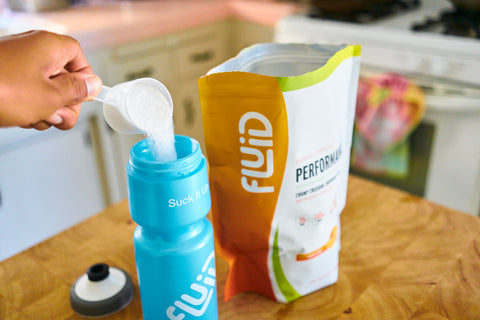This post comes from the blog over at Carmichael Training Systems. We recently partnered with them to share knowledge and provide FLUID Recovery for their athletes and training camps. If you’re in need of top-level coaching for any sport, we definitely recommend checking them out.
By Jason Koop
Head Coach of CTS Ultrarunning
For the last several weeks, I have been running into more and more content that either alludes to, or outright says, that sugar and sports nutrition products are addictive. Lay articles, influencers on social media, and nutrition company marketing departments alike have been routinely sounding these alarms, either in an effort to push a particular narrative or just out of plain ignorance. I’ll be clear right out of the gate: your sports nutrition products are not addictive. Similarly, sugar is not addictive to humans. However, rather than take my word for it, I’ll walk you through how we got here and what the current literature says.
Why ‘Sugar Addiction’ is worth discussing
Substance and behavioral addiction should not be addressed lightly. Individuals with substance or behavioral addictions (oftentimes referred to as process addiction) should seek qualified medical help. Addictions, regardless of whether they are to illicit drugs, gambling, sex, or alcohol have the power to ruin lives and entire families when not treated seriously and properly. And, many people fall victims to various addictions. By some estimates, approximately half of the US population will engage in some sort of addictive behavior each year.
The ultrarunning world is quite literally filled with active and recovering addicts from across the spectrum. In my coaching career, no less than 30% of my athlete roster has been filled with active or recovering addicts of some sort: drugs, alcohol, food, gambling, you name it. Famous ultrarunning personalities like Catra Corbett, Rich Roll, Timothy Olson (whom I currently coach) and my late friend David Clark all have been public about their struggles with various forms of addiction. They have also been open and honest about how running, in a twisted way, might be their way of substituting one addiction for another (and I will save that debate for another day).
Because of these personal connections to active and recovering addicts, you bet I pay attention when the word ‘addiction’ gets thrown around. If sugar or sports nutrition products were addictive, advising athletes I work with to ‘eat a gel’ or ‘drink a bottle of sports drink’ would potentially cause harm, and that would be the last thing I’d want to do. But sugar is not addictive to humans, and the only reason this is even remotely controversial is because of science that’s been misapplied.
A story about pigs
When I was an undergraduate, one of the research projects I was involved in was an American Heart Association study on pigs. In order to mimic human cardiovascular disease (like a blockage in a coronary artery), we artificially occluded one of the coronary arteries in each pig. Then we divided the pigs up into three groups. One group led their normal lives. The second group ran on a treadmill 5 days per week. The last group did a high intensity interval session 5 days per week. If you are wondering, the interval workout was 4X10 min fast, 5 min slow, which hilariously resembles a TempoRun workout I might prescribe a runner now.
At the end of the study, we looked at the pig’s hearts, the oxidative damage in the muscles, and a host of other things. Turns out, the interval-trained pigs fared better than the regular exercising pigs, and both groups did better than the sedentary pigs. So why pigs? Pigs are great cardiovascular analogs to humans. They also are good exercisers (imagine that) and were tickled pink just to get on the treadmills we had specially retrofitted for the experiment.
However, pigs are not perfect cardiovascular analogs. So, the research team was quick to point out that although the exercise and interval protocols were effective in mitigating the consequences of cardiovascular disease, we were only able to demonstrate this in pigs, not humans. We had a speculative mechanism (exercise), and had even tuned that mechanism to be relevant for humans (the hour of exercise and intervals being relatable doses of exercise). We were then able to test that mechanism on an animal model (pigs) and found it plausible that a similar intervention would be effective for humans (exercise can prevent worsening of cardiovascular disease, in this case). Fast forward two decades and exercise, even high intensity exercise, has been extensively studied and is prescribed for humans with cardiovascular disease (with some limitations).
Moving on to rats…
What does all this have to do with sugar addiction? Well, the origins of this narrative follow a similar pathway, but with a different animal: rats. Rats have long been used in research to study aspects of addiction, such as reward behavior, withdraw and tolerance. They have been fed all manners of drugs and substances including cocaine, methamphetamine, THC, aspartame and yes, even sugar. They run through mazes of increasing complexity and withstand intense electrical shocks to examine motivation for these substances. Tolerances are tested by super dosing the animals with amounts 20, 40, 100 and sometimes over 1000 times the normal amounts seen in humans. Withdraw is studied by removing the substance for a period of time and examining behavior and physiological responses during the withdraw period and after reintroduction. When it comes to this type of research, rats are the real guinea pigs.
While mechanistic studies involving rats and addictive responses to sugar have been studied for decades, the mainstream ‘sugar is addictive’ narrative picked up steam after this 2007 paper, in which rats could choose between saccharin sweetened water and intravenous cocaine. In this study, rats were presented with two different levers they could push. Pushing one resulted in access to the sweetened water and pressing the other lever resulted in an intravenous dose of cocaine. After learning which lever was which, the rats ultimately preferred to press the lever containing saccharin vs. the lever that delivered the cocaine. Thus, the research team concluded, “Our findings clearly demonstrate that intense sweetness can surpass cocaine reward.” So, there you have it, the rat’s biological reward for all things sweet is greater than for cocaine and voila, the ‘sugar is addictive for humans’ narrative caught fire.
Loads of additional rat studies have been conducted since then. Some examined withdraw symptoms like teeth chattering and tremors upon removing sugar from the rats’ diet. Others withheld all sustenance for up to 36 hours, then let them gorge on sugar water (and boy did they). Others have even demonstrated that female rats are more prone to addictive-like qualities compared to males. Sorry ladies, you are double screwed. If you want to dive down the rabbit, err, rat hole deep enough, you will find a lifetime’s worth of research to review, the majority of which indicates that rats will prefer sugar more than drugs, sex, their own livelihood, and endless reruns of Seinfeld, combined. It’s a pretty dreary picture unless you happen own massive acres of sugar cane fields (or the rights to Seinfeld).
Sugar addiction in humans?
So, all of this rat data seems super compelling, if not downright scary. If I were coaching ultrarunning rats, I would not let them come within earth’s orbit of a gel or coke. But as interesting as the rat data is, I could give a rat’s ass about it (you knew that was coming). Animal models are great for an initial proof of concept. But for any of it to be translatable, we have to see the same evidence in human populations. And we don’t, not by a long shot. Unlike the pigs, where we can literally take the same exercise protocols and apply them to humans, the rat studies are not as translatable.
There’s a good reason we’ll never see these types of case-controlled studies in humans. We can’t put humans in a box and make them press one lever for sugar and another one for cocaine. We can’t starve humans for 36 hours then give them unfettered access to only a sugary drink.
There’s also some common sense to keep in mind. In the human world, sugar is freely and cheaply available. We can choose when, where and how much of it to buy. If sugar were anywhere near as addictive to humans as it was in the rat models, we’d see people going to their nearest grocery store in droves, boiling down economy size bags of sugar right in the middle of the baking section, and proceeding to immediately mainline it without a second thought (almost like the rats do in their experiments). Walter White would come out of retirement and find a way to synthetically cook it in the back of his RV. We would see our ultrarunning brethren who are also recovering cocaine addicts (and there are a lot of these folks in the community) uncontrollably gorge themselves with gels, gummy bears and ginger ale at every single aid station, because, don’t-ya-know, sugar is more addictive than cocaine. We don’t see this. Not even close.
Research conducted on actual humans demonstrates this as well. This 2016 review article in the European Journal of Nutrition summarized all of the available animal and human data and found no compelling reason to incorporate ‘sugar addiction’ into the scientific vernacular. Even in human populations where food addiction (which some experts will term eating addiction) is an issue, sugar-laden foods only minimally contribute to dependence. If anything, high-fat savory foods and high-fat sweet foods contribute to dependency markedly more, which suggests that the energy density of foods is more important than sugar content when it comes to addiction and/or dependency.
Yet, you will still hear the narrative that sugar (and the sugar in your favorite sports nutrition product) is addictive. Rest assured, it’s not. While there are animal models that could lead one to believe that sugar has addictive properties, we don’t see this play out in human behavior or in the research.
So, what advice do I give my athletes regarding sugar? First, follow the guidelines and position statements established by reputable sports nutrition and sports science organizations, like the American College of Sports Medicine, International Society of Sports Nutrition, and the Academy of Nutrition and Dietetics. Consume a varied diet rich in fruits, vegetables, lean proteins, and fat. Reduce lifestyle consumption of highly processed, concentrated sources of added sugar, but consume exogenous carbohydrate (including simple sugar) during prolonged (60-90 minutes or longer) exercise bouts. The guidelines from these organizations are backed by decades of solid science, not “sugar industry conspiracies”.



